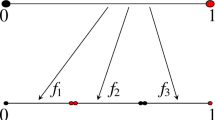Abstract
It is proved that every pseudo-self-affine tiling in ℝd is mutually locally derivable with a self-affine tiling. A characterization of pseudo-self-similar tilings in terms of derived Voronoï tessellations is a corollary. Previously, these results were obtained in the planar case, jointly with Priebe Frank. The new approach is based on the theory of graph-directed iterated function systems and substitution Delone sets developed by Lagarias and Wang. Bibliography: 18 titles.
Similar content being viewed by others
References
M. Baake and M. Schlottmann, “Geometric aspects of tilings and equivalence concepts,” in: Proceedings of the 5th International Conference on Quasicrystals, World Scientific, Singapore (1995), pp. 15–21.
M. Baake, M. Schlottmann, and P. D. Jarvis, “Quasiperiodic tilings with tenfold symmetry and equivalence with respect to local derivability,” J. Phys. A, 24, 4637–4654 (1991).
C. Holton, C. Radin, and L. Sadun, “Conjugacies for tiling dynamical systems,” arXiv:math.DS/0307259.
R. Kenyon and A. Vershik, “Arithmetic construction of sofic partitions of hyperbolic toral automorphisms,” Ergodic Theory Dynam. Systems, 18, No. 2, 357–372 (1998).
J. C. Lagarias and Y. Wang, “Substitution Delone sets,” Discrete Comput. Geom., 29, 175–209 (2003).
J.-Y. Lee, R. V. Moody, and B. Solomyak, “Consequences of pure point diffraction spectra for multiset substitution systems,” Discrete Comput. Geom., 29, 525–560 (2003).
D. Lind and B. Marcus, An Introduction to Symbolic Dynamics and Coding, Cambridge Univ. Press, Cambridge (1995).
K. Petersen, “Factor maps between tiling dynamical systems,” Forum Math., 11, 503–512 (1999).
N. M. Priebe, “Detecting hierarchy in tiling dynamical systems via derived Voronoï tesselations, ” Ph.D. Thesis, University of North Carolina at Chapel Hill (1997).
N. M. Priebe, “Towards a characterization of self-similar tilings in terms of derived Voronoï tesselations,” Geom. Dedicata, 79, 239–265 (2000).
N. M. Priebe and B. Solomyak, “Characterization of planar pseudo-self-similar tilings,” Discrete Comput. Geom., 26, 289–236 (2001).
C. Radin and L. Sadun, “Isomorphism of hierarchical structures,” Ergodic Theory Dynam. Systems, 21, 1239–1248 (2001).
B. Rand, “Equivalence of self-similar and pseudo-self-similar tiling spaces in ℝ2,” Preprint (2004).
E. A. Robinson, Jr., “Symbolic dynamics and tilings of ℝd,” in: Symbolic Dynamics and Its Applications, Proc. Sympos. Appl. Math., 60, Amer. Math. Soc., Providence, Rhode Island (2004), pp. 81–119.
D. J. Rudolph, “Markov tilings of ℝn and representations of ℝn actions,” in: Measure and Measurable Dynamics, Amer. Math. Soc., Providence, Rhode Island (1989), pp. 271–290.
N. Sidorov and A. Vershik, “Bijective arithmetic codings of hyperbolic automorphisms of the 2-torus, and binary quadratic forms,” J. Dynam. Control Systems, 4, No. 3, 365–399 (1998).
B. Solomyak, “Dynamics of self-similar tilings,” Ergodic Theory Dynam. Systems, 17, 695–738 (1997); corrections: Ergodic Theory Dynam. Systems, 19, 1685 (1999).
A. Vershik, “Arithmetic isomorphism of hyperbolic automorphisms of a torus and of sofic shifts,” Funct. Anal. Appl., 26, No. 3, 170–173 (1992).
Author information
Authors and Affiliations
Additional information
Published in Zapiski Nauchnykh Seminarov POMI, Vol. 326, 2005, pp. 198–213.
Rights and permissions
About this article
Cite this article
Solomyak, B. Pseudo-self-affine tilings in ℝd . J Math Sci 140, 452–460 (2007). https://doi.org/10.1007/s10958-007-0452-3
Received:
Issue Date:
DOI: https://doi.org/10.1007/s10958-007-0452-3



